~ 33a ~
~ The Study of Threes ~
http://threesology.org
Researchers as of 8/29/2019
| Devil's Advocate Series: | ||||||||
|---|---|---|---|---|---|---|---|---|
| 1 | 2 | 3 | 4 | 5 | 6 | 7 | 8 | 9 |
| 10 | 11 | 12 | 13 | 14A 14B |
15 | 16 | 17 | 18 |
| 19 | 20 | 21 | 22A 22B |
23 | 24 | 25 | 26 | 27 |
| 28 | 29 | 30 A 30 B |
31 | 32 | 33a 33b 33c |
34 | 35 | 36 |
| 37 | 38 | 39 | 40 | 41 A 41 B |
||||
In grouping different musical instruments and their players together, we might for example, refer to the arrangement as a solo act, duet, trio, quartet, quintet, sextet, band, or orchestra, though other labels may be used to indicate one or more given types of instrument, or the demographics of the person or group (such as age or gender or place of origination). Variations on this theme are sometimes to be noted and added to this list that I am not trying to be definitive about. However, there are a variety of terms which come to be used more or most frequently in given subject areas, and are used by its users as a tell-tale sign of whether a person is knowledgeable about the subject. It is generally thought that if you don't use the same language, the same vernacular, the same idioms in the same way, you can not think, much less discuss a given topic very intelligently. While many of us know this is wrong headedness, those who practice this philosophy actually describe their own inability to adapt their knowledge to a variety of generalist themes in order to more easily communicate their ideas to a broader spectrum of people whose own knowledge contain many of the same underlying basic patterns.
Let us take for example the recurring pattern of 1- 2- many.
The "1" and "many" show up in the expression "E Pluribus Unum", being used as the motto of the United States. This is not to say that just because the U.S. government uses this pattern, it therefore automatically has great value. The same goes for every single pattern being espoused by a person and/or institution that regularly uses a given expression or idea. Its usage simply reflects their interest and directed energies, or at least this may be what they want others to think.
The "2" in the "1-2-many" pattern is missing. Just because it is missing doesn't mean we have to dismiss the "1- many" grouping in our patterns-of-threesological considerations. Likewise if we find these two separated, though when found in a singular mode of presence, the notion of similarity may not be readily accepted by everyone as part of an overall consideration unless similarities have been accounted for in order to make a comparison and larger value judgment. Likewise the three-patterned "functional- non-functional- intermittently functional/non-functional" needs to be included. Additionally, if we have... for example, a pattern such as 2,3,4,8, we should not be so inclined to focus on the presence of the "3" since the third value of "6" is absent from the 2,4,8 ensemble of three which are 3 positive integers being related to 1 negative integer. Whether the absence is a cognitive "fluke" (irregularity) or an indication of some as yet unrecognized cognitive regularity has yet to be determined since this pattern has not been routinely recorded in all its varieties nor set to be examined in such a way as to make one or another determination. Cognitive psychology is barely beginning its gestation... or perhaps even cellular development past egg insemination or implantation.
I now refer to the "1- 2- many" as a pattern-of-three ensemble, though I did not always do so. The idea that there are different "groupings of threes" needed its own categorical heading to help in establishing a more expansive acknowledgment of different patterns which needed to be collated, many of which expressed absences of one or more internalized indicators, such as the "2" in the foregoing example. Indeed, the notion of a regular item being absent in some instances took awhile for me to recognize as a recurring pattern as well. Hence, though I thought that the recurrence of patterns-of-three was an interesting, if not important pattern to take an extended stock of, I was forced to include when such a pattern was absent, and seemingly replaced by some other pattern that I sometimes stretched my imagination in an effort to deduce a pattern-of-three in the alternative pattern being viewed. This is where the idea of a three-to-one ratio came into play, in order to address the many so-called patterns-of-four. I was trying to create a formula to account for the regular occurrence of the four pattern being used as an extension, elaboration or embellishment of the three-pattern.
This then has led to the idea that some perceived patterns-of-three, like the assumed Trigram illustrations of the I-Ching are merely masqueraded "personalities"... or dressed up variations of patterns-of-two, indicating that while the human brain in some individuals is reaching out beyond the two-patterned world-view, there is no complete metamorphosis; only a transition to what might be described as a cognitive way-station where their mind is awaiting that which may not occur for them in their given circumstances or even in this time period. While their current situation did initiate a means by which they progressed beyond a given norm amongst family, friends, relatives, co-workers, or fellow students, etc., it does not provide the same level or type of impetus-generating medium to assist them in taking a step beyond this... with the caveat that if they might achieve such, their "super-sanity" might well make them a very odd, strange or eccentric character to those they come in contact with in their day-to-day encounters within the social sphere they now inhabit, though such might not be the case if they were elsewhere, such as with other like-minded orientations.
Then again, if they are overtly self-conscious, and harbor an expectation for behaving in what they assume to be "normalized" or "socialized" behavior, observed changes in themselves might cause them to be irrationally alarmed, particularly if they were to acquire a multi-fold increase in I.Q. or sustained ability to embrace what others might describe as revelations or acknowledgement of presumed "messages" from subtleties they had previously overlooked or customarily taken for granted... not to mention acquiring that which might be discerned by others as a dangerous supernatural ability; and that they now recognize they are equipped with but are not likewise enabled to convey their new-found perceptions in a mode and manner which might help others recognize the same and have no need to fear, whereby their excitement is misjudged by those whose mentality remains in the common state of comatose-like zombiism that the world's many societies are relating to one another with, and internally functioning as. One's "re-arrangement" of perceptions and responses there-to could well be interpreted as a derangement, similar to when those of the past expressed differences of opinion against a prevailing norm and were either sacrificed for some supposed agricultural or weather benefit, or some believed- in higher social or spiritual purpose (often disguising someone's ulterior motive to acquire someone's resources)... like being burned at a stake, subjected to trephination, tied to a dunking stool, imprisoned in an asylum, and multiple other so-called "rational" acts of God-given and legal system supported goodness, equality and justice appealing to the mindset of those living in an Age of Irrationality which persists to this day and children are forced by way of indoctrination to abide by, be patriotic to, and defer action against in the name of some phony formula of made-up religious belief, business/economic policy, or exceptionally ridiculous Legislative-Judicial-Executive system of falsified Democracy, Communism, Socialism, Libertarianism, Anarchism, etc.
While I have found the "1-2-many" expression being used by those studying the origin of number development in the thinking of humans as an indication of a progressive development, I now also see it being used by nature, such as in the case of cellular division. For example, we have one cell that divides into two cells that is thereafter doubled, producing what can be referred to as "many doublings". The expected "three" in this numerical sequence is absent and replaced by the notion of "many", since cellular processing doesn't exceed the activity of doubling. It is an effect that might be described as a conservation, but I am thinking more along the lines of an environmentally induced biological constraint being imposed.
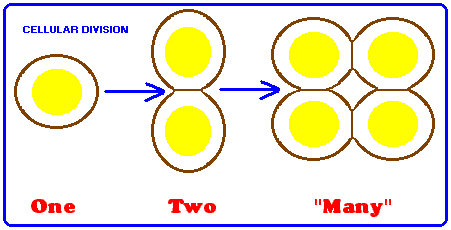
This "doubling" effect is taking place not only in the binary code used by computer programmers based on the "doubling" or dichotomous character of the electrical switch with its on/off value, it also is taking place with the babbling behavior of infants. Infants are noted as using a consonant/vowel grouping such as ba, da, na, etc., though the overall limitation of expressions is never placed into a context to be compared with other dichotomies taking place in other subjects... regardless if one thinks the early stages of babbling reflect a primary physiological formation with or without a major attendance of brain activity. As the stage or stages of babbling proceed towards the usage of words, we find there is a usage of what are called "reduplications", which are 'repetitions" by another name.
In other words, the "consonant/vowel" patterns-of-two are being doubled, and no one yet has assigned a relationship between the notions of positive/negative (cation/anion, high energy/low energy, light/dark, etc...) to the labels of consonant/vowel, (or the mouth/anus dichotomy noted on a previous page in this series). Hence, a presumed "third" or "three" value is implied by that which occurs next in line after a recognizable "two" event, though it is merely a doubled- doubling, and not an actual triple form. The "consonant/vowel" arrangement can be viewed as an expression of polarization, being found in biology, physics, mathematics, philosophy, political science, sociology, music, art, sports, etc... It is a basic pattern that is no doubt recognized by some and perhaps employed as part of their own adapted yin/yang (duality) variation, however it may be labeled or applied. Yet, the recurrence is not being used to identify the presence of what some might refer to as a conservation of behavior or a conservation of cognition (or mental activity), though I prefer to view it as an expression of an already mentioned constraint that we should be concerned with.
In contrast to the repletion of the "two", we find that in music, or at least song writing, we encounter the notion of the "hook", which commonly refers to repeating a word, phrase or melody three times, though this quantity may be varied in given instances. Unfortunately, there is a frequent usage of words like "catchy" or "memorable" to refer to the description of using a hook, but not a usage of applied patterns. While many hear and may repeat the repetition, they may be unable to tell you how often the repetition occurs or the pattern of the repetition itself, whether it is doubled, triple, quadrupled, etc..., and whether or not an enclosed singularity, dichotomy or syllogism is being used, though other geometric identities are possible... though infrequently used.
Infrequently used................ Yep, the infrequency of occurrence to be contrasted with frequency or quantity of appearance, though one might take the word "frequency" and visualize it in terms of the electromagnetic spectrum whereby an array or flurry of associations come to mind, leading one into the consideration of different subjects. It is an activity of mind that if vocalized, sounds like the description of what has been described as a mental illness:
Clang associations are groupings of words, usually rhyming words, that are based on similar-sounding sounds, even though the words themselves don't have any logical reason to be grouped together. A person who is speaking this way may be showing signs of psychosis in bipolar disorder or schizophrenia.
Typically, such "clang" associations are frequently made in a singular context that becomes elaborated on in a given subject, though many a creative thinker have little difficulty in thinking of multiple inter-connectivities of different ideas without being led astray into areas which begin affecting their day to day lives in negative ways. Cognitive scientists very often find what some may consider to be disparate, vague, illusory or make-believe connections between different subjects or ideas in an effort to unravel basic patterns. The same goes for different researchers, poets, mathematicians, artists, etc... They find comparisons and analogies which are useful attributes in helping them become more specialized in their respective generalities. Let us take nature for example.
While we humans construct patterns that can be reduced to enumeration which describe basic forms and processes, we nonetheless make up the patterns to coincide with what we think we see. Others may see one or another pattern instead of agreeing with us. Yet, when we collate all the different patterns we find that only a small number of patterns are being used over and over again, in all the different subjects humans have concerned themselves with. For all the trillions and otherwise infinity of number patterns available for usage, there are only a few patterns being repeated. While this may be due to some unrecognized Natural law, it may also be a tell-tell sign of an environmentally imposed biological restriction for the purpose of adaptation in an incrementally deteriorating environment which demands a certain type and level of activity to maintain a particular form... if not model, of equilibrium.
However, with respect to psychology linked to an older perspective obsessed with viewing the world in patterns-of-two described as "persistent dichotomies", let us note some of them to make the reader be wary of the present stage of psychology philosophy that has not developed into recognizing the existence of a "trichotomous" world-view orientation that frequently comes into conflict with a two-patterned orientation being practiced in given familial settings, workplaces, school rooms, and with oneself, because the "self" is cast into a dichotomous us/them, me/you, etc., formula of behavioral expectation, and not permitted the necessary latitude to develop their own trichotomous me/myself/I, you/yourself/thy formulation.
Current psychology is unknowingly describing the presence of a conflict between an expectation that a person abide with an older pattern-of-two worldview, and not permitted to transition into a pattern-of-three world view orientation, or in some cases, the reverse of this is occurring for some... though many try with varying results; often with self-depreciating lifestyles and attributions used in an attempt to define the acceptance of a person "as they truly are", or at least as they think themselves to be... sometimes conveyed with the phrase "this is who I am" (take it or leave it).
A person that has tried to adapt to a pattern-of-two world view may have incorporated behaviors which are meant to keep them tied to such an association, while their brain is struggling to set itself on its inclined course of adopting a pattern-of-three perspective. When a person's behavior binds them to a restricted orientation that does not stay restricted because of all the external models of "three" being presented to them via different modes of information, a conflict may ensue. While some find a means to permit their inclination to adopt a three-patterned world-view by engaging in thoughts focused on one or more patterns-of-three (such as the trinity in religion, or the many threes in science, or some other three organizational pattern in a different subject), not everyone learns to find a path to the usage, if not construction of a personal pattern-of-three usage.
If we look at the following description of Schizophrenia, we see the usage of a reference to 1 (such as a recurring 1%), to 2 (described as dichotomies such as adolescence/adulthood or coherent/incoherent), and three (described as thirds):
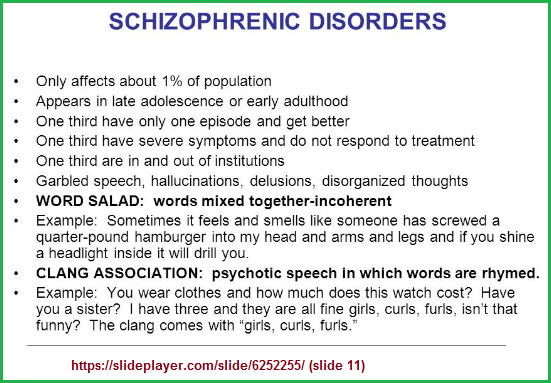
Psychology and references thereto is a persistent usage of dichotomies such as (for a short example):
- Bipolar I/ Bipolar II (notice there is no reference to mono-polar or tripolar, etc...)
- Manic/ Depression (Schizophrenia is sometimes described as a third disorder)
- Sanity/ Insanity (Though "super-sanity" is a third option.)
- "different" (viewed positively)/ "different" (viewed negatively)
- common/ uncommon
- Nature/ Nurture
- Male/ Female (genderist dichotomy)
- normal and natural/ non-normal and non-natural
- evil/ good (and their multiplicity of alternative labels)
- Terms to use/ Terms to avoid in describing mental illness
The so-called mental illnesses being described, aside from those which are obviously due to some physiological formation such as a genetic disturbance, are not routinely described in terms of a difference in orientation related to simple patterns. Patterns which become distorted, entangled, and convoluted by the many behavioral activities being used to try to establish a person as they truly are or think themselves to be... or want to be. While dietary changes, changes in environment, changes in relationship can help, they can also bind one to a pattern because the person repeats a self-defeating pattern that has become unknowingly engrained and repeated in different contexts. The chains of their thought and behavior are not actually being broken by their own efforts and need the assistance of one or more who keep them from falling back into their old routines and cyclicities, because the familiarity is comforting... though it may be abusive.
Let me suggest, as others have already done, that schizophrenia and other so-named mental dis-orders persist because they have some survival value, since they survive, unless we want to describe the presence of a "Natural" occurrence of that which creates the recurrence of disorders like mutations that are being crown like cancers. So too must we then consider that some of our ideas, though millions may believe in them, are expressions of wide-spread mental illness, that some claim to be the case for religion, war, etc... No less, are some of the patterns we identify in the forms and functionality of natural occurrences an expression of a nature-born illness that we interpret to be normal, natural and may even describe as a necessary law?
For example, is the recurrence of a positive and negative charge the result of some underlying "illness" occurring in the present structure of nature, or is this interpretation the result of an illness affecting perception? Likewise for the recurrence of DNA's triple code and the presence of the proton-neutron-electron ensemble. Does the recurrence make us feel comfortable because of its presumed certainty, or have we merely projected a need for consistency onto that being perceived, and shy away from cataloguing discrepancy to the extent of studying not only frequency of occurrence, but an absence thereof?
Does the binary code being used in computers represent an expression of a natural illness infecting the planet which in turn infects life on it and forces us to adopt it as being normal and natural, thus setting up a social reverence to its presence and an underlying inclination to persist in its usage just as the institution of psychology persists in the usage of dichotomies, though its usage is already noted as being out of date? For example:
The inadequacies of dichotomous views of behavioral development that oppose learned and innate behavior, or genetic and environmental determinants of behavior, have long been recognized. However, they continue to exert a powerful influence on current thinking about development, often by way of metaphors that simply recast these old ideas in a more modern technical vocabulary. The idea that the information for behavior can be attributed to either genetic or environmental sources was originated by Lorenz and provides the basis for many current dichotomous accounts of behavioral development. Lorenz's "sources of information" metaphor for development is fundamentally flawed, however, as are those more recent accounts that are based on it. The alternative interactionist account of development, most clearly articulated by Lehrman, is a far more powerful and coherent theoretical framework for development, but it has not been broadly assimilated into psychology and continues to be widely misunderstood. In particular, the interactionist account does not involve a radical environmentalism, does not attribute all behavior to the effects of learning, and does not interpret development as a gene-environment interaction. The attractive simplicity of dichotomous thinking encourages its continued application to the study of development despite the fact that it is clearly inadequate to the complexities of developmental analysis.
The Persistence of Dichotomies in the Study of Behavioral Development By Timothy D. Johnston, 1987, Developmental Review, 7:149-172.
Note: While there are other articles that are of value in making references to, many of them... too many of them... are behind you-have-to-pay-for-them walls. Hence, many in the public who are doing research like myself do not have access to the material. While those researchers have clear access to our ideas, and can use them without giving credit, thereby claiming them as their own if they are so inclined, like so many inequalities being practiced today, science and research can be a very prejudiced club with strict admission requirements... whose pass word is often described in terms of money.
While it is often the case where non-mechanical ideas adopt mechanical, electrical, biological, atomic, etc., models to be incorporated into their considerations, the reverse is not always the case... because the underlying models are not readily seen or collated to produce the parameters for the whole array of patterns being utilized, even when experts in the field of psychology or philosophy, for example, do not recognize the extent of the patterns being used or how to collate them into a larger application involving numerous subjects without becoming entwined in a line of thinking aligned with an exercise in semantics that produces a circularity of thought frequently used as a means for dismissing the effort to look at a larger array of fundamental patterns over a wide spectrum of subjects.
Whereas the idea of dichotomies is easily grasped and one may easily align with it the consonant/vowel labels, whether or not a clear association with a positive and negative attribute is likewise acknowledged; a further analogy into the ideas of analog and digital may be linked to an unfamiliarity due to no clear relevance unless one makes a case for the presence of recurring cognitive themes representing general similarities. The reason being is to point out different examples of basic (low number value) patterns being repeated, and their established used in such a way that large institutions and commercialized applications may give them the appearance of being anything but normal and natural... and in any case, not an indication of some aberrant behavior that nature might be exhibiting. Thus, by suggesting and ideally exhibiting the possibility that humanity is involved in a relationship with an illness of nature, a cure for the illness may not be thought of nor sought to remove oneself from.
Let us thus venture into the realm of the adopted digital world-view, as opposed to the analog world-view and usage, by making the suggestion that humanity has once again engaged in a dichotomous orientation, though the labeling and application may give the illusion that such ideas could not but be something that is normally occurring and not the product of some misaligned activity of nature.
Let us start with a simple definition of both analog and digital when applied to electrical signaling:
- Analog: using an oscilloscope, analog signals are seen as continuous sine waves that change (up and down) over time.
- Digital: using an oscilloscope, digital signals are seen as non-continuous, discrete square waves.
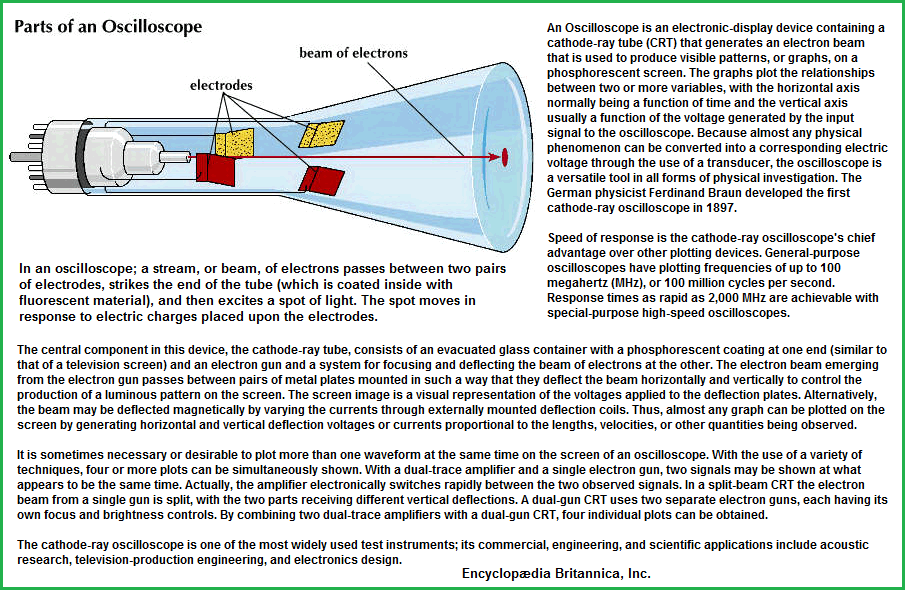
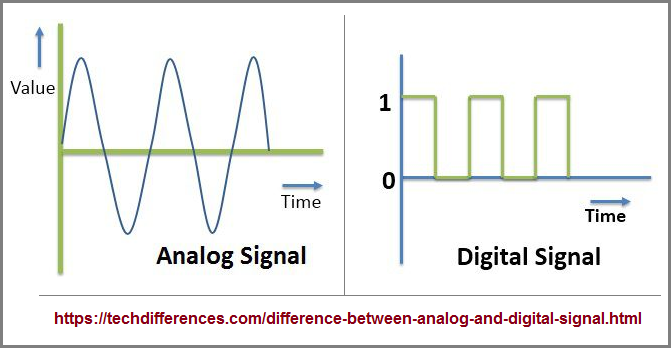
While some readers may not see these two (analog/digital) as opposites, they are none-the-less being paired, just as some people view the arrangement of men and women not as opposites, but as complements that compliment each other's differences. Analogously, some readers may not interpret negative and positive as being oppositional nor consonants and vowels or the mouth and anus as being diametrically opposed... just as the presumed mirror-imaging of the bilateral body form is interpreted in the same manner that some might want to think there is a necessity for sanity to have a bit of craziness about it, so as to be able recognize itself... as we often place the definition of peace as an opposite of war, though the presence of a non-war does not automatically guarantee peace when defined as an absence of poverty, hunger, disease, etc....
Just as we can look at the world through a two-patterned frame of reference, so too can we look at it through a three-patterned orientation, an example of which is to describe an analysis of a pattern-of-two as being logical, whereas in looking at a three from a two-patterned perspective, one of the three either get combined or excluded so as to facilitate an easier comprehension. With regard to applying a three-patterned (called logic) perspective on a two-patterned organization, we might come up with the following with respect to electronic circuity, but fail to take a look at interconnectivity in biological processes that primarily exhibit an analogical circuitry and never subjected to the question of why doesn't the analog of biology evolve into a digital usage, if it is as valuable as we think it is?
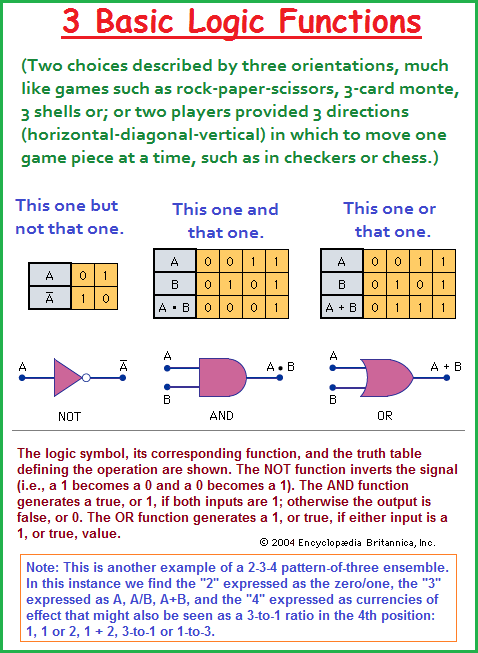
Here is one reference taking a look at the nature of the analog versus digital signals in biological substrates:
Analog synthetic biology
Abstract
We analyse the pros and cons of analog versus digital computation in living cells. Our analysis is based on fundamental laws of noise in gene and protein expression, which set limits on the energy, time, space, molecular count and part-count resources needed to compute at a given level of precision. We conclude that analog computation is significantly more efficient in its use of resources than deterministic digital computation even at relatively high levels of precision in the cell. Based on this analysis, we conclude that synthetic biology must use analog, collective analog, probabilistic and hybrid analog–digital computational approaches; otherwise, even relatively simple synthetic computations in cells such as addition will exceed energy and molecular-count budgets. We present schematics for efficiently representing analog DNA–protein computation in cells. Analog electronic flow in subthreshold transistors and analog molecular flux in chemical reactions obey Boltzmann exponential laws of thermodynamics and are described by astoundingly similar logarithmic electrochemical potentials. Therefore, cytomorphic circuits can help to map circuit designs between electronic and biochemical domains. We review recent work that uses positive-feedback linearization circuits to architect wide-dynamic-range logarithmic analog computation in Escherichia coli using three transcription factors, nearly two orders of magnitude more efficient in parts than prior digital implementations.
Analog synthetic biology by R. Sarpeshkar
- It's an Analog World by Herbert M. Sauro & Kyung Hyuk Kim: The first synthetic genetic circuits to use analog computation have been developed. These circuits involve fewer components and resources, and can execute more complex operations, than their digital counterparts.
- Being Analog by Don Norman, 17 November 2008:
We are analog beings trapped in a digital world, and the worst part is, we did it to ourselves.
We humans are biological animals. We have evolved over millions of years to function well in the environment, to survive. We are analog devices following biological modes of operation. We are compliant, flexible, tolerant. Yet we people have constructed a world of machines that requires us to be rigid, fixed, intolerant. We have devised a technology that requires considerable care and attention, that demands it be treated on its own terms, not on ours. We live in a technology-centered world where the technology is not appropriate for people. No wonder we have such difficulties.
Here we are, wandering about the world, bumping into things, forgetful of details, with a poor sense of time, a poor memory for facts and figures, unable to keep attention on a topic for more than a short duration, reasoning by example rather than by logic, and drawing upon our admittedly deficient memories of prior experience. When viewed this way, we seem rather pitiful. No wonder that we have constructed a set of artificial devices that are very much not in our own image. We have constructed a world of machinery in which accuracy and precision matter. Time matters. Names, dates, facts, and figures matter. Accurate memory matters. Details matter...
- Synthetic mixed-signal computation in living cells by Jacob R. Rubens, Gianluca Selvaggio & Timothy K. Lu:
Abstract— Abstract Living cells implement complex computations on the continuous environmental signals that they encounter. These computations involve both analogue- and digital-like processing of signals to give rise to complex developmental programs, context-dependent behaviours and homeostatic activities. In contrast to natural biological systems, synthetic biological systems have largely focused on either digital or analogue computation separately. Here we integrate analogue and digital computation to implement complex hybrid synthetic genetic programs in living cells. We present a framework for building comparator gene circuits to digitize analogue inputs based on different thresholds. We then demonstrate that comparators can be predictably composed together to build band-pass filters, ternary logic systems and multi-level analogue-to-digital converters. In addition, we interface these analogue-to-digital circuits with other digital gene circuits to enable concentration-dependent logic. We expect that this hybrid computational paradigm will enable new industrial, diagnostic and therapeutic applications with engineered cells.
So here we are. Identifying differences that we assume can be integrated to produce a better mouse trap (so to speak) called the human/machine hybrid. Instead of actually developing a third system, we provide ourselves with the illusion of a third by integrating two... or is it a one that has merely been doubled... that is, reduplicated like some adult-generated cognitively babbled sequence?
Let's continue this discussion onto the next page.
Origination date: Wednesday, October 23rd, 2019... 3:32 AM
Initial Posting: Wednesday, October 20th, 2019... 5:33 AM
Updated Posting: Friday, January 20th, 2023... 12:29 PM
Herb O. Buckland
herbobuckland@hotmail.com